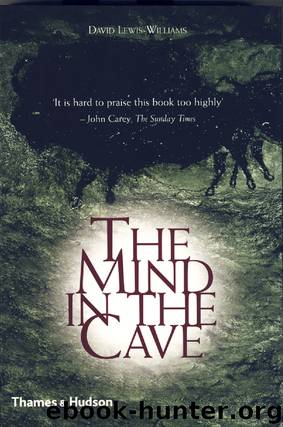The Mind in the Cave by David Lewis-Williams

Author:David Lewis-Williams [Lewis-Williams, David]
Language: eng
Format: epub
Tags: art history, sociology, psychology, archaeology, anthropology, religion, history, prehistory
ISBN: 9780500770306
Publisher: Thames and Hudson Ltd
Published: 2002-12-14T00:00:00+00:00
43 North American rock art images depicting shamanistic experience: A Flight; the figure wears a quail topknot; B and C Winged flight; D Underwater; a salamander swimming around a saltwater kelp plant; E Transformation of a shaman into a rattlesnake; rattlesnake shamans cured snake bites and controlled snakes.
Bodily transformation, Whitley’s last metaphor, is so common in both North America and southern Africa that it hardly needs further comment. On both continents, shamans fuse with animals and experience bodily distortions (Fig. 43E).
This list of metaphors – or rationalizations of altered states of consciousness – presents a mixture of somatic, aural, visual and mental experiences associated with trance. The similarities that I have outlined show that fundamental neurological events can be variously interpreted, but also that these events are nevertheless likely to be seen in certain ways. Underlying all these shamanistic experiences is the concept of supernatural power and the ways in which it can be harnessed in altered states of consciousness.
Quartz and supernatural power
One of the most fascinating findings to emerge from recent North American rock art research concerns a link between the way in which engravings were pecked, or hammered, into the rock and a manifestation of supernatural power. To demonstrate this link, Whitley and four of his associates focused on a Mojave Desert site known as Sally’s Rock Shelter. They found that pieces of quartz were scattered around the engraved rocks; they had been used as hammer-stones. Unmodified white quartz cobbles, approximately 12 cm (5 in) long, were also wedged in cracks between boulders (Pl. 10). It is common to find offerings of beads, sticks, arrows, seeds, berries and special stones at vision quest sites.
This is by no means the only rock art site associated with quartz; the stone is widely associated with shamanism. For instance, Bob Rabbit, the last known Numic rain-shaman, used quartz crystals in his weather-control ceremonies, and crystals were believed to be inhabited by spirits.57 More specifically, reports show that shamanistic vision questers in the Colorado Desert ‘would break up white quartz rocks, believing that the high spiritual power contained within these would be released to enter his or her body’.58 The scatter of quartz fragments at Sally’s Rock Shelter apparently resulted from this practice.
The reason for the practice of breaking open quartz seems to be that, when quartz stones are rubbed together, they generate a bright, lightning-like light. Triboluminescence, as this characteristic is known, became a manifestation of supernatural power. Although striking quartz against basalt in the act of making an image will not activate triboluminescence, the scatters of quartz fragments found at rock art sites suggest the importance of the mineral as intrinsically containing power. Here is another instance of rituals that were performed at rock art sites.
Images in society
An important point that emerges from this discussion and from Chapter 5 is that the insights of shamans are accepted by their communities. People who have never moved to the end of the intensified spectrum none the less believe in a tiered cosmos,
Download
This site does not store any files on its server. We only index and link to content provided by other sites. Please contact the content providers to delete copyright contents if any and email us, we'll remove relevant links or contents immediately.
The Art of Thinking Clearly by Rolf Dobelli(10321)
Mindhunter: Inside the FBI's Elite Serial Crime Unit by John E. Douglas & Mark Olshaker(9260)
Change Your Questions, Change Your Life by Marilee Adams(7684)
Nudge - Improving Decisions about Health, Wealth, and Happiness by Thaler Sunstein(7656)
Mastermind: How to Think Like Sherlock Holmes by Maria Konnikova(7278)
The Power of Now: A Guide to Spiritual Enlightenment by Eckhart Tolle(5679)
Men In Love by Nancy Friday(5192)
Altered Sensations by David Pantalony(5071)
Factfulness: Ten Reasons We're Wrong About the World – and Why Things Are Better Than You Think by Hans Rosling(4713)
The Confidence Code by Katty Kay(4220)
Thinking in Bets by Annie Duke(4184)
Man and His Symbols by Carl Gustav Jung(4094)
The Worm at the Core by Sheldon Solomon(3450)
Why Buddhism is True by Robert Wright(3423)
Liar's Poker by Michael Lewis(3413)
Three Women by Lisa Taddeo(3391)
The Inner Life of Animals by Peter Wohlleben(3285)
Descartes' Error by Antonio Damasio(3247)
How Music Works by David Byrne(3233)
